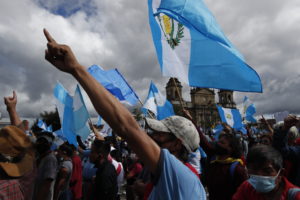THE NORTHERN TRIANGLE IN DATA
El Salvador
The Central America Monitor presents robust quantitative data primarily obtained through official information requests in several key areas. These data assess advances, setbacks, or stalling on specific human rights and rule of law issues from 2014 to 2021. Below, start by viewing the data regionally or clicking on a country. Then, select a section. Under each section, select a specific indicator to explore the corresponding data points. You may also download the raw data or share the graphics.
El Salvador has high levels of inequality and poverty. In this section, we display its socioeconomic situation as background for all subsequent sections. We aim to provide broad centralized and reliable data that can serve as a starting point for further investigation. As such, we decided to include disaggregated data only when immediately relevant to the sections we monitor.
!function(){“use strict”;window.addEventListener(“message”,(function(a){if(void 0!==a.data[“datawrapper-height”])for(var e in a.data[“datawrapper-height”]){var t=document.getElementById(“datawrapper-chart-“+e)||document.querySelector(“iframe[src*='”+e+”‘]”);t&&(t.style.height=a.data[“datawrapper-height”][e]+”px”)}}))}();
Sources: General Directorate of Statistics and Censuses; United Nations Population Fund; Latin American and Caribbean Demographic Centre, Publication Division of ECLAC.
!function(){“use strict”;window.addEventListener(“message”,(function(e){if(void 0!==e.data[“datawrapper-height”]){var t=document.querySelectorAll(“iframe”);for(var a in e.data[“datawrapper-height”])for(var r=0;r<t.length;r++){if(t[r].contentWindow===e.source)t[r].style.height=e.data["datawrapper-height"][a]+"px"}}}))}();
Sources: General Directorate of Statistics and Censuses; United Nations Population Fund; Latin American and Caribbean Demographic Centre, Publication Division of ECLAC.
!function(){“use strict”;window.addEventListener(“message”,(function(e){if(void 0!==e.data[“datawrapper-height”]){var t=document.querySelectorAll(“iframe”);for(var a in e.data[“datawrapper-height”])for(var r=0;r<t.length;r++){if(t[r].contentWindow===e.source)t[r].style.height=e.data["datawrapper-height"][a]+"px"}}}))}();
Notes: The Salvadoran government does not update its population projections annually by race or ethnicity. Consequently, the figure shown in a given year derives from the last census that took place: 2007 in El Salvador.
Source: 2007 population and housing census of El Salvador.

Note: El Salvador’s 2007 census did not include a denomination for afro-descendants.
!function(){“use strict”;window.addEventListener(“message”,(function(e){if(void 0!==e.data[“datawrapper-height”]){var t=document.querySelectorAll(“iframe”);for(var a in e.data[“datawrapper-height”])for(var r=0;r<t.length;r++){if(t[r].contentWindow===e.source)t[r].style.height=e.data["datawrapper-height"][a]+"px"}}}))}();
Sources: General Directorate of Statistics and Censuses of El Salvador; World Bank.
!function(){“use strict”;window.addEventListener(“message”,(function(e){if(void 0!==e.data[“datawrapper-height”]){var t=document.querySelectorAll(“iframe”);for(var a in e.data[“datawrapper-height”])for(var r=0;r<t.length;r++){if(t[r].contentWindow===e.source)t[r].style.height=e.data["datawrapper-height"][a]+"px"}}}))}();
Sources: General Directorate of Statistics and Censuses of El Salvador; World Bank.
!function(){“use strict”;window.addEventListener(“message”,(function(e){if(void 0!==e.data[“datawrapper-height”]){var t=document.querySelectorAll(“iframe”);for(var a in e.data[“datawrapper-height”])for(var r=0;r<t.length;r++)t[r].contentWindow===e.source&&(t[r].style.height=e.data["datawrapper-height"][a]+"px")}}))}();
Source: General Directorate of Statistics and Censuses.
!function(){“use strict”;window.addEventListener(“message”,(function(e){if(void 0!==e.data[“datawrapper-height”]){var t=document.querySelectorAll(“iframe”);for(var a in e.data[“datawrapper-height”])for(var r=0;r<t.length;r++){if(t[r].contentWindow===e.source)t[r].style.height=e.data["datawrapper-height"][a]+"px"}}}))}();
Source: World Bank.
!function(){“use strict”;window.addEventListener(“message”,(function(e){if(void 0!==e.data[“datawrapper-height”]){var t=document.querySelectorAll(“iframe”);for(var a in e.data[“datawrapper-height”])for(var r=0;r<t.length;r++){if(t[r].contentWindow===e.source)t[r].style.height=e.data["datawrapper-height"][a]+"px"}}}))}();
Note: In El Salvador, the rates were calculated using the average minimum salary that the government established for different sectors: commerce and services; maquila and textiles; industry; crop collection; seasonal agriculture; and agricultural and livestock farming.
Source: Ministry of Labor and Social Welfare of El Salvador.
!function(){“use strict”;window.addEventListener(“message”,(function(e){if(void 0!==e.data[“datawrapper-height”]){var t=document.querySelectorAll(“iframe”);for(var a in e.data[“datawrapper-height”])for(var r=0;r<t.length;r++){if(t[r].contentWindow===e.source)t[r].style.height=e.data["datawrapper-height"][a]+"px"}}}))}();
Note: The figures shown were calculated to represent per capita costs of basic provisions, known as the “basic basket of goods” (canasta básica). In El Salvador, the figures represent the average cost of basic food provisions for rural and urban areas.
Source: General Directorate of Statistics and Censuses of El Salvador.
!function(){“use strict”;window.addEventListener(“message”,(function(e){if(void 0!==e.data[“datawrapper-height”]){var t=document.querySelectorAll(“iframe”);for(var a in e.data[“datawrapper-height”])for(var r=0;r<t.length;r++){if(t[r].contentWindow===e.source)t[r].style.height=e.data["datawrapper-height"][a]+"px"}}}))}();
Source: General Directorate of Statistics and Censuses of El Salvador.
!function(){“use strict”;window.addEventListener(“message”,(function(e){if(void 0!==e.data[“datawrapper-height”]){var t=document.querySelectorAll(“iframe”);for(var a in e.data[“datawrapper-height”])for(var r=0;r<t.length;r++){if(t[r].contentWindow===e.source)t[r].style.height=e.data["datawrapper-height"][a]+"px"}}}))}();
Source: General Directorate of Statistics and Censuses of El Salvador.
!function(){“use strict”;window.addEventListener(“message”,(function(e){if(void 0!==e.data[“datawrapper-height”]){var t=document.querySelectorAll(“iframe”);for(var a in e.data[“datawrapper-height”])for(var r=0;r<t.length;r++){if(t[r].contentWindow===e.source)t[r].style.height=e.data["datawrapper-height"][a]+"px"}}}))}();
Note: The literacy rate refers to the percentage of people who can read and write, and includes those older than 10 years in El Salvador.
Source: General Directorate of Statistics and Censuses of El Salvador.
!function(){“use strict”;window.addEventListener(“message”,(function(e){if(void 0!==e.data[“datawrapper-height”]){var t=document.querySelectorAll(“iframe”);for(var a in e.data[“datawrapper-height”])for(var r=0;r<t.length;r++){if(t[r].contentWindow===e.source)t[r].style.height=e.data["datawrapper-height"][a]+"px"}}}))}();
Sources: General Directorate of Statistics and Censuses of El Salvador; World Bank.
Amidst the very high levels of violence for the general population in El Salvador, justice system officials, lawyers, and LGBTQ+ persons face among the highest rates of threats, aggressions and killings in the world. We show how even for their higher profile cases, few actually enter the justice system and end in sentencing.
!function(){“use strict”;window.addEventListener(“message”,(function(e){if(void 0!==e.data[“datawrapper-height”]){var t=document.querySelectorAll(“iframe”);for(var a in e.data[“datawrapper-height”])for(var r=0;r<t.length;r++){if(t[r].contentWindow===e.source)t[r].style.height=e.data["datawrapper-height"][a]+"px"}}}))}();
Note: The annual data regarding legal complaints provided by the Office of the Public Defender for Human Rights do not correspond to the calendar year. The period consists of June from one year (which is the year denoted in the chart) through May of the following year. For example, the 2014 data point in the chart represents June 2014 through May 2015.
Sources: Passionate Social Service, based on data provided by the Public Prosecutor’s Office.
Honduras, Guatemala and El Salvador have among the world’s highest homicide rates and high rates of extortion and sexual violence, even though the latter are gravely underreported. We chose these crimes, because while homicide is the serious crime that most affects males, sexual violence is the serious crime that most affects females, and extortion affects broad segments of all sectors of society. We show how few cases actually enter the justice system and end in sentencing, thus creating a cycle of impunity for even the worst crimes.
!function(){“use strict”;window.addEventListener(“message”,(function(e){if(void 0!==e.data[“datawrapper-height”]){var t=document.querySelectorAll(“iframe”);for(var a in e.data[“datawrapper-height”])for(var r=0;r<t.length;r++){if(t[r].contentWindow===e.source)t[r].style.height=e.data["datawrapper-height"][a]+"px"}}}))}();
Source: Public Prosecutor’s Office of El Salvador.
!function(){“use strict”;window.addEventListener(“message”,(function(e){if(void 0!==e.data[“datawrapper-height”]){var t=document.querySelectorAll(“iframe”);for(var a in e.data[“datawrapper-height”])for(var r=0;r<t.length;r++){if(t[r].contentWindow===e.source)t[r].style.height=e.data["datawrapper-height"][a]+"px"}}}))}();
Source: Public Prosecutor’s Office.
!function(){“use strict”;window.addEventListener(“message”,(function(e){if(void 0!==e.data[“datawrapper-height”]){var t=document.querySelectorAll(“iframe”);for(var a in e.data[“datawrapper-height”])for(var r=0;r<t.length;r++){if(t[r].contentWindow===e.source)t[r].style.height=e.data["datawrapper-height"][a]+"px"}}}))}();
Source: Public Prosecutor’s Office.
!function(){“use strict”;window.addEventListener(“message”,(function(e){if(void 0!==e.data[“datawrapper-height”]){var t=document.querySelectorAll(“iframe”);for(var a in e.data[“datawrapper-height”])for(var r=0;r<t.length;r++){if(t[r].contentWindow===e.source)t[r].style.height=e.data["datawrapper-height"][a]+"px"}}}))}();
Source: Public Prosecutor’s Office.
!function(){“use strict”;window.addEventListener(“message”,(function(e){if(void 0!==e.data[“datawrapper-height”]){var t=document.querySelectorAll(“iframe”);for(var a in e.data[“datawrapper-height”])for(var r=0;r<t.length;r++){if(t[r].contentWindow===e.source)t[r].style.height=e.data["datawrapper-height"][a]+"px"}}}))}();
Note: The figures shown also include cases of deprivation of liberty (privación de libertad).
Source: Public Prosecutor’s Office of El Salvador.
!function(){“use strict”;window.addEventListener(“message”,(function(e){if(void 0!==e.data[“datawrapper-height”]){var t=document.querySelectorAll(“iframe”);for(var a in e.data[“datawrapper-height”])for(var r=0;r<t.length;r++){if(t[r].contentWindow===e.source)t[r].style.height=e.data["datawrapper-height"][a]+"px"}}}))}();
Source: Public Prosecutor’s Office of El Salvador.
!function(){“use strict”;window.addEventListener(“message”,(function(e){if(void 0!==e.data[“datawrapper-height”]){var t=document.querySelectorAll(“iframe”);for(var a in e.data[“datawrapper-height”])for(var r=0;r<t.length;r++){if(t[r].contentWindow===e.source)t[r].style.height=e.data["datawrapper-height"][a]+"px"}}}))}();
Source: Public Prosecutor’s Office of El Salvador.
!function(){“use strict”;window.addEventListener(“message”,(function(e){if(void 0!==e.data[“datawrapper-height”]){var t=document.querySelectorAll(“iframe”);for(var a in e.data[“datawrapper-height”])for(var r=0;r<t.length;r++){if(t[r].contentWindow===e.source)t[r].style.height=e.data["datawrapper-height"][a]+"px"}}}))}();
Note: No information was available regarding the establishment or start of operations for the Special Prosecutor’s Office for Asset Recovery for 2014 or 2015. The figures shown represent the number of prosecutors and assistant prosecutors.
Source: Public Prosecutor’s Office.
!function(){“use strict”;window.addEventListener(“message”,(function(e){if(void 0!==e.data[“datawrapper-height”]){var t=document.querySelectorAll(“iframe”);for(var a in e.data[“datawrapper-height”])for(var r=0;r<t.length;r++){if(t[r].contentWindow===e.source)t[r].style.height=e.data["datawrapper-height"][a]+"px"}}}))}();
Note: The figures shown represent judges and magistrates. No information was available regarding the establishment or start of operations for Specialized Courts of Sentence or Instruction for a Life Free of Violence and Discrimination for Women for 2014, 2015, or 2016. No data was available in any year for the Specialized Chamber for a Life Free of Violence and Discrimination for Women.
Source: Supreme Court of Justice.
!function(){“use strict”;window.addEventListener(“message”,(function(e){if(void 0!==e.data[“datawrapper-height”]){var t=document.querySelectorAll(“iframe”);for(var a in e.data[“datawrapper-height”])for(var r=0;r<t.length;r++){if(t[r].contentWindow===e.source)t[r].style.height=e.data["datawrapper-height"][a]+"px"}}}))}();
Note: No data was available for 2014 or 2015. The Counternarcotics Division includes personnel from the Canine Unit, Special Counternarcotics Group, Investigations Department of the Counternarcotics Division, Joint Counternarcotics Intelligence Center, regional Counternarcotics coordination offices, and Counternarcotics sections in the districts San Salvador-Sur, Ciudad Delgado, Santa Ana, Ahuachapán and La Libertad-Norte for 2016 and 2017; and in Sonsonate and Usulután for 2017 only.
Source: National Civilian Police.
!function(){“use strict”;window.addEventListener(“message”,(function(e){if(void 0!==e.data[“datawrapper-height”]){var t=document.querySelectorAll(“iframe”);for(var a in e.data[“datawrapper-height”])for(var r=0;r<t.length;r++){if(t[r].contentWindow===e.source)t[r].style.height=e.data["datawrapper-height"][a]+"px"}}}))}();
Note: The figures shown represent the number of forensic experts with jurisdiction in criminal matters.
Source: Institute of Forensic Medicine.
!function(){“use strict”;window.addEventListener(“message”,(function(e){if(void 0!==e.data[“datawrapper-height”]){var t=document.querySelectorAll(“iframe”);for(var a in e.data[“datawrapper-height”])for(var r=0;r<t.length;r++){if(t[r].contentWindow===e.source)t[r].style.height=e.data["datawrapper-height"][a]+"px"}}}))}();
Note: The figures shown represent the total budget allocation for the Institute of Forensic Medicine.
Source: Institute of Forensic Medicine.
!function(){“use strict”;window.addEventListener(“message”,(function(e){if(void 0!==e.data[“datawrapper-height”]){var t=document.querySelectorAll(“iframe”);for(var a in e.data[“datawrapper-height”])for(var r=0;r<t.length;r++){if(t[r].contentWindow===e.source)t[r].style.height=e.data["datawrapper-height"][a]+"px"}}}))}();
Note: The figures shown refer to the number of public defenders with jurisdiction in criminal matters.
Source: Public Defender’s Office of the Republic.
El Salvador has characteristics of a kleptocratic state, with illicit networks at every level that have penetrated most public and private institutions. This is part of why inequality and poverty persist, because the money meant for public services is misdirected. Through public confidence surveys, we show that citizens know these dynamics, and thus, do not trust their institutions, despite existing laws. These frameworks are not enough in the face of lacking willingness and capacity. Given how pervasive corruption is, we present how few cases of the seven most impactful crimes – abuse of authority, bribery, embezzlement, fraud, illicit enrichment, influence peddling, and malfeasance – actually get reported. Within this small sample of reported crimes, we show how few cases actually enter the justice system and end in sentencing. Even in these, the sentences are incredibly light, demonstrating at every step that authorities do not actually seek to tackle corruption.
!function(){“use strict”;window.addEventListener(“message”,(function(e){if(void 0!==e.data[“datawrapper-height”]){var t=document.querySelectorAll(“iframe”);for(var a in e.data[“datawrapper-height”])for(var r=0;r<t.length;r++){if(t[r].contentWindow===e.source)t[r].style.height=e.data["datawrapper-height"][a]+"px"}}}))}();
Note: The figures represent the country’s score and ranking on Transparency International’s Corruption Perceptions Index, which measures the perceived levels of public sector corruption in some 180 countries.
Source: Transparency International.
Despite ongoing efforts to reform and professionalize the police, abuses and crimes committed by them remain incredibly common. Such abuses must end before citizens can trust their security forces as protectors rather than additional persecutors. Likewise, equal or greater investment in the justice system and social sectors is critical. Thus, we have focused the information in this section on the abuses being recorded and the personnel and budgetary resources available, so that the reader can compare across institutions.
-
Academy Enrollment and Graduation - Basic Level Graduation from Vocational Police Sciences Program Continuing Studies - Technical Advancements Continuing Studies - Specializations Remedial Courses for Candidates Seeking PNC Reenlistment Courses on Philosophy of Community Policing Promotions by Level Promotions by Sex
!function(){“use strict”;window.addEventListener(“message”,(function(e){if(void 0!==e.data[“datawrapper-height”]){var t=document.querySelectorAll(“iframe”);for(var a in e.data[“datawrapper-height”])for(var r=0;r<t.length;r++){if(t[r].contentWindow===e.source)t[r].style.height=e.data["datawrapper-height"][a]+"px"}}}))}();
Source: National Civilian Police.
!function(){“use strict”;window.addEventListener(“message”,(function(e){if(void 0!==e.data[“datawrapper-height”]){var t=document.querySelectorAll(“iframe”);for(var a in e.data[“datawrapper-height”])for(var r=0;r<t.length;r++){if(t[r].contentWindow===e.source)t[r].style.height=e.data["datawrapper-height"][a]+"px"}}}))}();
Note: No data was available for 2014 or 2015.
Source: National Civilian Police.
!function(){“use strict”;window.addEventListener(“message”,(function(e){if(void 0!==e.data[“datawrapper-height”]){var t=document.querySelectorAll(“iframe”);for(var a in e.data[“datawrapper-height”])for(var r=0;r<t.length;r++){if(t[r].contentWindow===e.source)t[r].style.height=e.data["datawrapper-height"][a]+"px"}}}))}();
Note: No data was available for 2014 or 2015. Subdirectorate personnel numbers do not account for the total police force.
Source: National Civilian Police.
!function(){“use strict”;window.addEventListener(“message”,(function(e){if(void 0!==e.data[“datawrapper-height”]){var t=document.querySelectorAll(“iframe”);for(var a in e.data[“datawrapper-height”])for(var r=0;r<t.length;r++){if(t[r].contentWindow===e.source)t[r].style.height=e.data["datawrapper-height"][a]+"px"}}}))}();
Source: National Public Security Academy.
!function(){“use strict”;window.addEventListener(“message”,(function(e){if(void 0!==e.data[“datawrapper-height”]){var t=document.querySelectorAll(“iframe”);for(var a in e.data[“datawrapper-height”])for(var r=0;r<t.length;r++){if(t[r].contentWindow===e.source)t[r].style.height=e.data["datawrapper-height"][a]+"px"}}}))}();
Note: The first graduation from the Vocational Police Sciences Program was in 2017.
Source: National Public Security Academy.
!function(){“use strict”;window.addEventListener(“message”,(function(e){if(void 0!==e.data[“datawrapper-height”]){var t=document.querySelectorAll(“iframe”);for(var a in e.data[“datawrapper-height”])for(var r=0;r<t.length;r++){if(t[r].contentWindow===e.source)t[r].style.height=e.data["datawrapper-height"][a]+"px"}}}))}();
Source: National Public Security Academy.
!function(){“use strict”;window.addEventListener(“message”,(function(e){if(void 0!==e.data[“datawrapper-height”]){var t=document.querySelectorAll(“iframe”);for(var a in e.data[“datawrapper-height”])for(var r=0;r<t.length;r++){if(t[r].contentWindow===e.source)t[r].style.height=e.data["datawrapper-height"][a]+"px"}}}))}();
Source: National Public Security Academy.
!function(){“use strict”;window.addEventListener(“message”,(function(e){if(void 0!==e.data[“datawrapper-height”]){var t=document.querySelectorAll(“iframe”);for(var a in e.data[“datawrapper-height”])for(var r=0;r<t.length;r++){if(t[r].contentWindow===e.source)t[r].style.height=e.data["datawrapper-height"][a]+"px"}}}))}();
Source: National Public Security Academy.
!function(){“use strict”;window.addEventListener(“message”,(function(e){if(void 0!==e.data[“datawrapper-height”]){var t=document.querySelectorAll(“iframe”);for(var a in e.data[“datawrapper-height”])for(var r=0;r<t.length;r++){if(t[r].contentWindow===e.source)t[r].style.height=e.data["datawrapper-height"][a]+"px"}}}))}();
Note: No data was available for 2016 or 2017.
Source: National Public Security Academy.
!function(){“use strict”;window.addEventListener(“message”,(function(e){if(void 0!==e.data[“datawrapper-height”]){var t=document.querySelectorAll(“iframe”);for(var a in e.data[“datawrapper-height”])for(var r=0;r<t.length;r++){if(t[r].contentWindow===e.source)t[r].style.height=e.data["datawrapper-height"][a]+"px"}}}))}();
Source: National Public Security Academy.
!function(){“use strict”;window.addEventListener(“message”,(function(e){if(void 0!==e.data[“datawrapper-height”]){var t=document.querySelectorAll(“iframe”);for(var a in e.data[“datawrapper-height”])for(var r=0;r<t.length;r++){if(t[r].contentWindow===e.source)t[r].style.height=e.data["datawrapper-height"][a]+"px"}}}))}();
Source: National Public Security Academy.
!function(){“use strict”;window.addEventListener(“message”,(function(e){if(void 0!==e.data[“datawrapper-height”]){var t=document.querySelectorAll(“iframe”);for(var a in e.data[“datawrapper-height”])for(var r=0;r<t.length;r++){if(t[r].contentWindow===e.source)t[r].style.height=e.data["datawrapper-height"][a]+"px"}}}))}();
Source: Ministry of Finance.
!function(){“use strict”;window.addEventListener(“message”,(function(e){if(void 0!==e.data[“datawrapper-height”]){var t=document.querySelectorAll(“iframe”);for(var a in e.data[“datawrapper-height”])for(var r=0;r<t.length;r++){if(t[r].contentWindow===e.source)t[r].style.height=e.data["datawrapper-height"][a]+"px"}}}))}();
Note: The figures shown represent budget execution for the PNC. No data was available for budget execution by the National Public Security Academy.
Source: Ministry of Finance.
!function(){“use strict”;window.addEventListener(“message”,(function(e){if(void 0!==e.data[“datawrapper-height”]){var t=document.querySelectorAll(“iframe”);for(var a in e.data[“datawrapper-height”])for(var r=0;r<t.length;r++){if(t[r].contentWindow===e.source)t[r].style.height=e.data["datawrapper-height"][a]+"px"}}}))}();
Source: National Civilian Police.
!function(){“use strict”;window.addEventListener(“message”,(function(e){if(void 0!==e.data[“datawrapper-height”]){var t=document.querySelectorAll(“iframe”);for(var a in e.data[“datawrapper-height”])for(var r=0;r<t.length;r++){if(t[r].contentWindow===e.source)t[r].style.height=e.data["datawrapper-height"][a]+"px"}}}))}();
Source: National Civilian Police.
!function(){“use strict”;window.addEventListener(“message”,(function(e){if(void 0!==e.data[“datawrapper-height”]){var t=document.querySelectorAll(“iframe”);for(var a in e.data[“datawrapper-height”])for(var r=0;r<t.length;r++){if(t[r].contentWindow===e.source)t[r].style.height=e.data["datawrapper-height"][a]+"px"}}}))}();
Source: National Civilian Police.
!function(){“use strict”;window.addEventListener(“message”,(function(e){if(void 0!==e.data[“datawrapper-height”]){var t=document.querySelectorAll(“iframe”);for(var a in e.data[“datawrapper-height”])for(var r=0;r<t.length;r++){if(t[r].contentWindow===e.source)t[r].style.height=e.data["datawrapper-height"][a]+"px"}}}))}();
Source: National Civilian Police.
!function(){“use strict”;window.addEventListener(“message”,(function(e){if(void 0!==e.data[“datawrapper-height”]){var t=document.querySelectorAll(“iframe”);for(var a in e.data[“datawrapper-height”])for(var r=0;r<t.length;r++){if(t[r].contentWindow===e.source)t[r].style.height=e.data["datawrapper-height"][a]+"px"}}}))}();
Note: The figures shown represent cases of homicide, injuries, torture, femicide, and unlawful curtailment of freedom of movement.
Source: National Civilian Police.
The justice system faces numerous challenges. To provide national context to the other sections and a jumping-off point for comparisons with other countries outside the region, we display the global totals of all crimes, budget, staff and particularly relevant personnel for three categories: the prosecution, judiciary and public defense.
-
Summary of Court Cases Cases Pending at Start of Year in the Judiciary Criminal Cases Registered in the Judiciary Cases Closed in the Judiciary Cases Heard in the Judiciary Court Dismissals Court Sentences Cases Initiated by Prosecutors Criminal Charges Filed by Prosecutors Cases Archived by Prosecutors Cases Assigned to Public Defenders Cases Closed by Public Defenders Cases Archived by Public Defenders Forensic Expert Examinations Conducted Autopsies Conducted
!function(){“use strict”;window.addEventListener(“message”,(function(e){if(void 0!==e.data[“datawrapper-height”]){var t=document.querySelectorAll(“iframe”);for(var a in e.data[“datawrapper-height”])for(var r=0;r<t.length;r++){if(t[r].contentWindow===e.source)t[r].style.height=e.data["datawrapper-height"][a]+"px"}}}))}();
Sources: Public Prosecutor’s Office; Judiciary of El Salvador; General Directorate of Statistics and Censuses; Institute of Forensic Medicine; Public Defender’s Office of the Republic.
!function(){“use strict”;window.addEventListener(“message”,(function(e){if(void 0!==e.data[“datawrapper-height”]){var t=document.querySelectorAll(“iframe”);for(var a in e.data[“datawrapper-height”])for(var r=0;r<t.length;r++){if(t[r].contentWindow===e.source)t[r].style.height=e.data["datawrapper-height"][a]+"px"}}}))}();
Sources: Public Prosecutor’s Office; Judiciary of El Salvador; General Directorate of Statistics and Censuses; Institute of Forensic Medicine; Public Defender’s Office of the Republic.
!function(){“use strict”;window.addEventListener(“message”,(function(e){if(void 0!==e.data[“datawrapper-height”]){var t=document.querySelectorAll(“iframe”);for(var a in e.data[“datawrapper-height”])for(var r=0;r<t.length;r++){if(t[r].contentWindow===e.source)t[r].style.height=e.data["datawrapper-height"][a]+"px"}}}))}();
Note: The figures shown represent the total budget allocation for each institution.
Source: Ministry of Finance.
!function(){“use strict”;window.addEventListener(“message”,(function(e){if(void 0!==e.data[“datawrapper-height”]){var t=document.querySelectorAll(“iframe”);for(var a in e.data[“datawrapper-height”])for(var r=0;r<t.length;r++){if(t[r].contentWindow===e.source)t[r].style.height=e.data["datawrapper-height"][a]+"px"}}}))}();
Source: Ministry of Finance.
!function(){“use strict”;window.addEventListener(“message”,(function(e){if(void 0!==e.data[“datawrapper-height”]){var t=document.querySelectorAll(“iframe”);for(var a in e.data[“datawrapper-height”])for(var r=0;r<t.length;r++){if(t[r].contentWindow===e.source)t[r].style.height=e.data["datawrapper-height"][a]+"px"}}}))}();
Source: Judiciary of El Salvador.
Note: The figures reported in this section include the following crimes: homicide, extortion, drugs, human trafficking, femicide, rape, kidnapping and deprivation of liberty, threats, illegal limitation of free movement, money laundering, and terrorism.
!function(){“use strict”;window.addEventListener(“message”,(function(e){if(void 0!==e.data[“datawrapper-height”]){var t=document.querySelectorAll(“iframe”);for(var a in e.data[“datawrapper-height”])for(var r=0;r<t.length;r++){if(t[r].contentWindow===e.source)t[r].style.height=e.data["datawrapper-height"][a]+"px"}}}))}();
Sources: Public Prosecutor’s Office; General Directorate of Statistics and Censuses.
!function(){“use strict”;window.addEventListener(“message”,(function(e){if(void 0!==e.data[“datawrapper-height”]){var t=document.querySelectorAll(“iframe”);for(var a in e.data[“datawrapper-height”])for(var r=0;r<t.length;r++){if(t[r].contentWindow===e.source)t[r].style.height=e.data["datawrapper-height"][a]+"px"}}}))}();
Sources: Public Prosecutor’s Office; General Directorate of Statistics and Censuses.
Note: The figures reported in this section include the following crimes: homicide, extortion, drugs, human trafficking, femicide, rape, kidnapping and deprivation of liberty, threats, illegal limitation of free movement, money laundering, and terrorism.
!function(){“use strict”;window.addEventListener(“message”,(function(e){if(void 0!==e.data[“datawrapper-height”]){var t=document.querySelectorAll(“iframe”);for(var a in e.data[“datawrapper-height”])for(var r=0;r<t.length;r++){if(t[r].contentWindow===e.source)t[r].style.height=e.data["datawrapper-height"][a]+"px"}}}))}();
Sources: Public Defender’s Office of the Republic; General Directorate of Statistics and Censuses.
Note: The figures reported in this section include the following crimes: homicide, extortion, drugs, human trafficking, femicide, rape, kidnapping and deprivation of liberty, threats, illegal limitation of free movement, money laundering, and terrorism.
!function(){“use strict”;window.addEventListener(“message”,(function(e){if(void 0!==e.data[“datawrapper-height”]){var t=document.querySelectorAll(“iframe”);for(var a in e.data[“datawrapper-height”])for(var r=0;r<t.length;r++){if(t[r].contentWindow===e.source)t[r].style.height=e.data["datawrapper-height"][a]+"px"}}}))}();
Sources: Institute of Forensic Medicine; General Directorate of Statistics and Censuses.
!function(){“use strict”;window.addEventListener(“message”,(function(e){if(void 0!==e.data[“datawrapper-height”]){var t=document.querySelectorAll(“iframe”);for(var a in e.data[“datawrapper-height”])for(var r=0;r<t.length;r++){if(t[r].contentWindow===e.source)t[r].style.height=e.data["datawrapper-height"][a]+"px"}}}))}();
Source: Judiciary of El Salvador.
!function(){“use strict”;window.addEventListener(“message”,(function(e){if(void 0!==e.data[“datawrapper-height”]){var t=document.querySelectorAll(“iframe”);for(var a in e.data[“datawrapper-height”])for(var r=0;r<t.length;r++){if(t[r].contentWindow===e.source)t[r].style.height=e.data["datawrapper-height"][a]+"px"}}}))}();
Source: Judiciary of El Salvador.
!function(){“use strict”;window.addEventListener(“message”,(function(e){if(void 0!==e.data[“datawrapper-height”]){var t=document.querySelectorAll(“iframe”);for(var a in e.data[“datawrapper-height”])for(var r=0;r<t.length;r++){if(t[r].contentWindow===e.source)t[r].style.height=e.data["datawrapper-height"][a]+"px"}}}))}();
Source: Judiciary of El Salvador.
!function(){“use strict”;window.addEventListener(“message”,(function(e){if(void 0!==e.data[“datawrapper-height”]){var t=document.querySelectorAll(“iframe”);for(var a in e.data[“datawrapper-height”])for(var r=0;r<t.length;r++){if(t[r].contentWindow===e.source)t[r].style.height=e.data["datawrapper-height"][a]+"px"}}}))}();
Source: Judiciary of El Salvador.
!function(){“use strict”;window.addEventListener(“message”,(function(e){if(void 0!==e.data[“datawrapper-height”]){var t=document.querySelectorAll(“iframe”);for(var a in e.data[“datawrapper-height”])for(var r=0;r<t.length;r++){if(t[r].contentWindow===e.source)t[r].style.height=e.data["datawrapper-height"][a]+"px"}}}))}();
Source: Judiciary of El Salvador.
!function(){“use strict”;window.addEventListener(“message”,(function(e){if(void 0!==e.data[“datawrapper-height”]){var t=document.querySelectorAll(“iframe”);for(var a in e.data[“datawrapper-height”])for(var r=0;r<t.length;r++){if(t[r].contentWindow===e.source)t[r].style.height=e.data["datawrapper-height"][a]+"px"}}}))}();
Source: Judiciary of El Salvador.
!function(){“use strict”;window.addEventListener(“message”,(function(e){if(void 0!==e.data[“datawrapper-height”]){var t=document.querySelectorAll(“iframe”);for(var a in e.data[“datawrapper-height”])for(var r=0;r<t.length;r++){if(t[r].contentWindow===e.source)t[r].style.height=e.data["datawrapper-height"][a]+"px"}}}))}();
Source: Judiciary of El Salvador.
!function(){“use strict”;window.addEventListener(“message”,(function(e){if(void 0!==e.data[“datawrapper-height”]){var t=document.querySelectorAll(“iframe”);for(var a in e.data[“datawrapper-height”])for(var r=0;r<t.length;r++){if(t[r].contentWindow===e.source)t[r].style.height=e.data["datawrapper-height"][a]+"px"}}}))}();
Source: Public Prosecutor’s Office.
!function(){“use strict”;window.addEventListener(“message”,(function(e){if(void 0!==e.data[“datawrapper-height”]){var t=document.querySelectorAll(“iframe”);for(var a in e.data[“datawrapper-height”])for(var r=0;r<t.length;r++){if(t[r].contentWindow===e.source)t[r].style.height=e.data["datawrapper-height"][a]+"px"}}}))}();
Source: Public Prosecutor’s Office.
Note: The figures reported in this section include the following crimes: homicide, extortion, drugs, human trafficking, femicide, rape, kidnapping and deprivation of liberty, threats, illegal limitation of free movement, money laundering, and terrorism.
!function(){“use strict”;window.addEventListener(“message”,(function(e){if(void 0!==e.data[“datawrapper-height”]){var t=document.querySelectorAll(“iframe”);for(var a in e.data[“datawrapper-height”])for(var r=0;r<t.length;r++){if(t[r].contentWindow===e.source)t[r].style.height=e.data["datawrapper-height"][a]+"px"}}}))}();
Source: Public Prosecutor’s Office.
!function(){“use strict”;window.addEventListener(“message”,(function(e){if(void 0!==e.data[“datawrapper-height”]){var t=document.querySelectorAll(“iframe”);for(var a in e.data[“datawrapper-height”])for(var r=0;r<t.length;r++){if(t[r].contentWindow===e.source)t[r].style.height=e.data["datawrapper-height"][a]+"px"}}}))}();
Source: Public Defender’s Office.
!function(){“use strict”;window.addEventListener(“message”,(function(e){if(void 0!==e.data[“datawrapper-height”]){var t=document.querySelectorAll(“iframe”);for(var a in e.data[“datawrapper-height”])for(var r=0;r<t.length;r++){if(t[r].contentWindow===e.source)t[r].style.height=e.data["datawrapper-height"][a]+"px"}}}))}();
Source: Public Defender’s Office.
!function(){“use strict”;window.addEventListener(“message”,(function(e){if(void 0!==e.data[“datawrapper-height”]){var t=document.querySelectorAll(“iframe”);for(var a in e.data[“datawrapper-height”])for(var r=0;r<t.length;r++){if(t[r].contentWindow===e.source)t[r].style.height=e.data["datawrapper-height"][a]+"px"}}}))}();
Source: Public Defender’s Office.
!function(){“use strict”;window.addEventListener(“message”,(function(e){if(void 0!==e.data[“datawrapper-height”]){var t=document.querySelectorAll(“iframe”);for(var a in e.data[“datawrapper-height”])for(var r=0;r<t.length;r++){if(t[r].contentWindow===e.source)t[r].style.height=e.data["datawrapper-height"][a]+"px"}}}))}();
Source: Institute of Forensic Medicine.
!function(){“use strict”;window.addEventListener(“message”,(function(e){if(void 0!==e.data[“datawrapper-height”]){var t=document.querySelectorAll(“iframe”);for(var a in e.data[“datawrapper-height”])for(var r=0;r<t.length;r++){if(t[r].contentWindow===e.source)t[r].style.height=e.data["datawrapper-height"][a]+"px"}}}))}();
Source: Institute of Forensic Medicine.
In the first five years of CAM’s operation, the military in particular most denied our requests, such that we rarely got the information needed to monitor them. Furthermore, abuses and crimes committed by the military remained incredibly common – despite efforts at some points to limit their involvement in public security – and we were consistently able to get this information from other State institutions. Such abuses must end before citizens can trust their security forces as protectors rather than additional persecutors. Likewise, equal or greater investment in the justice system and social sectors is critical. Thus, we have focused the information in this section on the abuses being recorded and the personnel and budgetary resources available, so that the reader can compare across institutions.

Note: The Ministry of National Defense denied our request for information regarding the number of personnel within the Armed Forces, stating that the information is classified because its release may pose risks to national security and territorial integrity.
!function(){“use strict”;window.addEventListener(“message”,(function(e){if(void 0!==e.data[“datawrapper-height”]){var t=document.querySelectorAll(“iframe”);for(var a in e.data[“datawrapper-height”])for(var r=0;r<t.length;r++){if(t[r].contentWindow===e.source)t[r].style.height=e.data["datawrapper-height"][a]+"px"}}}))}();
Note: El Salvador had 11,200 authorized military personnel deployed until June 2014. As of July 2014, the government issed a new decree that authorized deployment of 7,900 troops.
Sources: University Institute for Public Opinion; Ministry of National Defense.
!function(){“use strict”;window.addEventListener(“message”,(function(e){if(void 0!==e.data[“datawrapper-height”]){var t=document.querySelectorAll(“iframe”);for(var a in e.data[“datawrapper-height”])for(var r=0;r<t.length;r++){if(t[r].contentWindow===e.source)t[r].style.height=e.data["datawrapper-height"][a]+"px"}}}))}();
Note: The figures shown refer to the total approved budget for the Ministry of National Defense, which does not have a specific budget line item for the Armed Forces. However, the line item category for Institutional Operational Management accounts for more than 90% of its budget, and encompasses maintenance of naval, aerial, and land forces. The information available indicates that the budget of the Armed Forces represents some 3% of the El Salvador’s total national budget.
Source: Ministry of Finance.
!function(){“use strict”;window.addEventListener(“message”,(function(e){if(void 0!==e.data[“datawrapper-height”]){var t=document.querySelectorAll(“iframe”);for(var a in e.data[“datawrapper-height”])for(var r=0;r<t.length;r++){if(t[r].contentWindow===e.source)t[r].style.height=e.data["datawrapper-height"][a]+"px"}}}))}();
Note: The annual data regarding legal complaints provided by the Office of the Public Defender for Human Rights do not correspond to the calendar year. The period consists of June from one year (which is the year denoted in the chart) through May of the following year. For example, the 2014 data point in the chart represents June 2014 through May 2015.
Sources: Ministry of National Defense; Office of the Public Defender for Human Rights.
!function(){“use strict”;window.addEventListener(“message”,(function(e){if(void 0!==e.data[“datawrapper-height”]){var t=document.querySelectorAll(“iframe”);for(var a in e.data[“datawrapper-height”])for(var r=0;r<t.length;r++){if(t[r].contentWindow===e.source)t[r].style.height=e.data["datawrapper-height"][a]+"px"}}}))}();
Source: Office of the Public Defender for Human Rights.
!function(){“use strict”;window.addEventListener(“message”,(function(e){if(void 0!==e.data[“datawrapper-height”]){var t=document.querySelectorAll(“iframe”);for(var a in e.data[“datawrapper-height”])for(var r=0;r<t.length;r++){if(t[r].contentWindow===e.source)t[r].style.height=e.data["datawrapper-height"][a]+"px"}}}))}();
Note: The data shown represent a sample of the main types of crimes registered during the period: homicides; injuries; threats; rape and sexual assaults; deprivation of liberty; arbitrary acts; damages; bribery; illegal possession, carrying, or use of firearms; trafficking of prohibited objects in prisons; association with illicit groups or terrorist organizations; and violence against women.
Source: Public Prosecutor’s Office.
Our Partners
WOLA is working in collaboration with the following organizations in Central America:
 |
 |
 |
| University Institute of Public Opinion El Salvador |
Myrna Mack Foundation Guatemala |
Institute on Democracy, Peace & Security Honduras |

